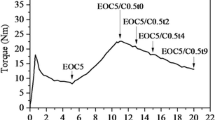Abstract
The effect of organoclay Cloisite®20A and controlled peroxide curing on the dielectric properties and flammability of LLDPE/EMA blend is explored in this article. The organoclay Cloisite®20A were melt blended with the LLDPE/EMA system at 1, 3, 5, and 7 wt% loading through the variation of the sequence of addition. The dielectric properties of the blend composites are evaluated at different temperature and frequency ranges. Results obtained reveal that the dielectric properties of LLDPE/EMA blend is influenced remarkably by extent of clay loading, variation of sequence of addition of organoclay, and controlled peroxide curing. Both the frequency and temperature dependency of dielectric constant is higher for filled samples than for control blend. On peroxide curing, dielectric constant decreases for all samples and is more significant in case of filled samples. The volume resistivity and breakdown voltage of the samples have also been evaluated. Limiting oxygen index of LLDPE/EMA blends is moderately improved on addition of organoclay.







Similar content being viewed by others
References
Tripathi AK, Pillai PKC (1985) Thermally stimulated depolarization studies on laminated films of cellulose triacetate and polystyrene. In: 5th International Symposium on Electrets IEEE, vol 138, pp 4–6
Mathes KN (1986) Electrical properties. In: Kroschwitz JI (ed) Encyclopedia of polymer science and engineering, vol 5. Wiley, New York, pp 507–587
Saxena P, Gaur MS, Khare PK, Tiwari RK (2011) Dielectric relaxation in polyvinylidenefluorideepolysulfone blends. J Electrostat 69:214–219
Shukla P, Gaur MS (2009) Investigation of electrical conduction mechanism in double-layered polymeric system. J Appl Polym Sci 114:222–230
Mongal N, Chakraborty D, Bhattacharyya R, Chaki TK, Bhattacharya P (2009) Effect of electron-beam irradiation on ethylene–methyl acrylate copolymer. J Appl Polym Sci 112:28–35
Piah MAM, Darus A, Arief YZ, Hassan A (2009) Electrical tracking and erosion properties of aged natural rubber-LLDPE blends. MPIC Conf 1:294–301
Ray I, Khastgir D (1994) Low density polyethylene and ethylene vinyl acetate copolymer blends as cable insulants. Plast Rub Comp Process Appl 22:37–45
Ray I, Khastgir D (1994) EVA-EPDM blends as cable insulants. J Appl Polym Sci 53:297–307
Denison DR, Barbour JC, Burkart JH (1996) Low dielectric constant, fluorine doped SiO2 for intermetal dielectric. J Vac Sci Technol A 14:1124–1126
Wang HW, Chang KC, Chu HC, Liou SJ, Yeh JM (2004) Significant decreased dielectric constant and loss of polystyrene–clay nanocomposite materials by using long-chain intercalation agent. J Appl Polym Sci 92:2402–2410
Zhang YH, Dang ZM, Fu SY, Xin JH, Deng JG, Wu J, Yang S, Li LF, Yan Q (2005) Dielectric and dynamic mechanical properties of polyimide–clay nanocomposite films. Chem Phy Let 401:553–557
Wang HW, Dong RX, Liu CL, Chang HY (2007) Effect of clay on properties of polyimide-clay nanocomposites. J Appl Polym Sci 104:318–324
Tanaka T, Montanari GC, Mulhaupt R (2004) Polymer nanocomposites as dielectrics and electrical insulation-perspectives for processing technologies, materials characterization and future applications. IEEE Trans Dielectr Electr Insul 11:763–784
Tanaka T (2005) Dielectric nanocomposites with insulating properties. IEEE Trans Dielectr Electr Insul 12:914–928
Yi X, Duan HL, Chen Y, Wang J (2007) Prediction of complex dielectric constants of polymer-clay nanocomposites. Phys Lett A 372:68–75
Hernandez MC, Suarez N, Martınez LA, Feijoo JL, Monaco SL, Salazar N (2008) Effect of nanoscale dispersion in the dielectric properties of poly(vinyl alcohol)/bentonite nanocomposites. Phys Rev E 77:051801.1–051801.10
Borah JS, Karak N, Chaki TK (2011) Effect of organoclay platelets on morphology and properties of LLDPE/EMA blends. Mater Sci Eng 528:2820–2830
Hui S, Chaki TK, Chattopadhyay S (2010) Dielectric properties of EVA/LDPE TPE system: effect of nanosilica and controlled irradiation. Polym Eng Sci 50:731–738
Borah JS, Chaki TK (2011) Dynamic mechanical, thermal, physico-mechanical and morphological properties of LLDPE/EMA blends. J Polym Res 18:569–578
Borah JS, Chaki TK (2010) Dynamic rheological, morphology and mechanical properties of compatibilized LLDPE/EMA blends. J Polym Res. doi:10.1007/s10965-010-9488-z
Maxwell JC (1892) Electricity and magnetism, vol 1. Oxford University Press, Oxford, p 452
Wagner KW (1914) Erklarung der dielektrischen Nachwirkungsvorgange auf grund Maxwellscher Vorstellungen. Arch Electrotech 2:371–387
Fothergill JC, Nelson JK, Fu M (2004) Dielectric properties of epoxy nanocomposites containing TiO2, Al2O3 and ZnO fillers. CEIDP Con Proc 406–409
Wang B, Tai Q, Nie S, Zhou K, Tang Q, Hu Y, Song L (2011) Electron beam irradiation cross linking of halogen-free flame-retardant ethylene vinyl acetate (EVA) copolymer by silica gel microencapsulated ammonium polyphosphate and char-forming agent. Ind Eng Chem Res 50:5596–5605
Peneva Y, Tashev E, Minkova L (2006) Flammability, microhardness and transparency of nanocomposites based on functionalized polyethylenes. Eur Polym J 42:2228
Zanetti M, Costa L (2004) Preparation and combustion behaviour of polymer/layered silicate nanocomposites based upon PE and EVA. Polymer 45:4367
Author information
Authors and Affiliations
Corresponding author
Rights and permissions
About this article
Cite this article
Borah, J.S., Chaki, T.K. & Sarkhel, G. Simultaneous effect of organoclay and controlled peroxide curing on dielectric properties and flammability of LLDPE/EMA blend. Polym. Bull. 68, 2255–2267 (2012). https://doi.org/10.1007/s00289-012-0711-4
Received:
Revised:
Accepted:
Published:
Issue Date:
DOI: https://doi.org/10.1007/s00289-012-0711-4




